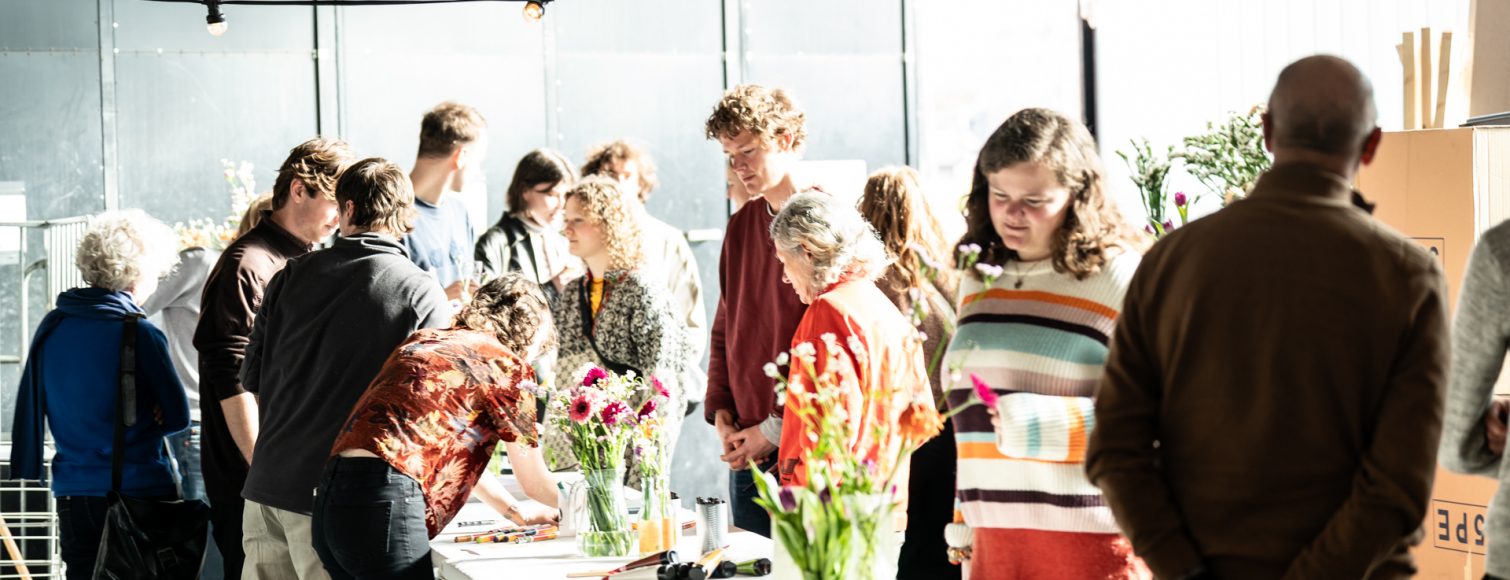I found it a beautiful quote from philosopher and biologist Andreas Weber during the For Love of the World festival. It’s about death, not a cheerful subject. But Weber reassured: ‘If you think death is a definitive end, it puts enormous pressure on our short lifespan. With so much pressure, you cannot build a tender relationship with the world. You lose yourself in the threat of the end.’
Weber starts from a radical standpoint: the interdependence and interconnectedness of forms of existence on this planet. Dying is not (only) the end of an individual, but merging into a larger whole. Of course, we grieve when we lose a loved one—such an idea won’t change that. But it is liberating concerning all the gloom and even apocalyptic visions of the end of civilizations and even the planet. Those paralyzed by a possible end ultimately achieve nothing.
The interdependence and interconnectedness of all forms of existence were the basis of the completely sold-out For Love of the World (FLOTW) festival at Theater De Veste. Because of this interconnectedness, the question arises whether we—humans—should see ourselves as the pinnacle of creation or as constantly co-evolving with everything around us. This is called posthumanism; not because we are bidding farewell to humans, but because the idea of being human is changing. The planet (or technology) does not revolve around us but forms a community with us. The planet is not an amusement park where you can have fun and cheerfully go home after 5 hours. We are in this together.
This applies to our interaction with nature but certainly also to technology. Yke Bauke Eijsma, researcher in human-robot interaction at TU Delft, showed this using robot dog Spot, which demonstrates that terms like care, affection, fear and even love also could apply in the interaction with technology. Aafke Fraaije, who researches the role that art can play in climate solidarity, showed how interconnectedness also applies to future generations; with a poetry workshop by spoken-word artist Nabil Tkhidousset. Joost Vervoort, researcher in Transformative Imagination in the Environmental Governance Group at the Copernicus Institute of Sustainable Development, led a guided meditation on the mystical, while Julia Rijssenbeek—PhD in philosophy at Wageningen University—showed her experimental film Cobalt, which explored the future relationship with technology through dance.
The fascinating thing is that these Dutch researchers show how science itself is increasingly intertwined with art forms—a return to the classics: science was still called art during ‘the seven liberal arts (artes)’ in the Middle Ages. But also with the fact that there is meaning, pondering about robot love, generations to come, and even the mystical feeling you are a part of a bigger whole (as science sometimes does: think about the ‘pale blue dot’ picture of our planet, sent to us by Voyager1, sent from a distance of approximately 6 billion kilometers from Earth).
In the main hall of De Veste, besides Weber, theoretical physicist Heinrich Päs (TU Dortmund) discussed netlike intricate fabric to which we all belong—viewed from the entanglement theory of quantum physics, and Elisa Giaccardi (former professor of post-industrial design at TU Delft) discussed how design is not a tool to be wielded according to our intentions but is a humble and adaptive attunement. And one where technology doesn’t just serve human needs but helps us connect to other-than-human scales and sensibilities, opening up new possibilities for our collective survival.
In addition to researchers, numerous student clubs were involved in the organization. Debates, art, making art oneself, music, and so on—too much to mention here. There were also artworks, and the AI assistant Aurora, created by New Media Centre of TU Delft.
As was said in the final discussion with some guests: this is a new paradigm. That is exactly what we felt during the evening. It is new; things still need to take shape. But we saw how the approach of interconnectedness and posthumanism offers profound value to science by fostering a more inclusive, ethical, and innovative approach to understanding and interacting with the world. By challenging anthropocentric biases and promoting interdisciplinary collaboration, posthumanism enriches scientific inquiry and encourages responsible advancements that benefit diverse forms of life. That is why we call it For love of the World.
Interconnectedness and posthumanism encourage researchers – and us all – to explore the agency and intelligence of non-human entities, such as animals, ecosystems, artificial intelligence, robot dogs, and the next generations. This shift in perspective leads to a more holistic understanding of complex systems and promotes ethical considerations in scientific practices, ensuring that advancements are made with empathy and respect for all beings.
Additionally, posthumanism inspires scientists to adopt interdisciplinary approaches that integrate insights from philosophy, cultural studies, and ethics into scientific endeavors. This holistic approach enables researchers to consider broader implications and societal impacts of their work, leading to more informed and responsible decision-making in scientific innovation.
In essence, posthumanism enriches science by promoting a more expansive and ethical vision of the future, where scientific advancements are aligned with values of diversity, empathy, and responsible stewardship of the natural world. This paradigm shift in scientific thinking holds the potential to create a more harmonious relationship between humans, technology, and the broader ecosystem, paving the way for transformative and inclusive progress in science and society. But besides that: it enriches science with existential questions like: why are we on earth? What is purpose?
And indeed, if we do embrace being part of a broader ecosystem – who would fear the end?

